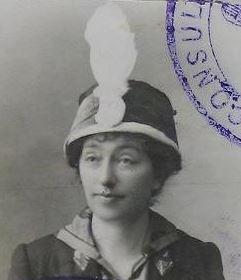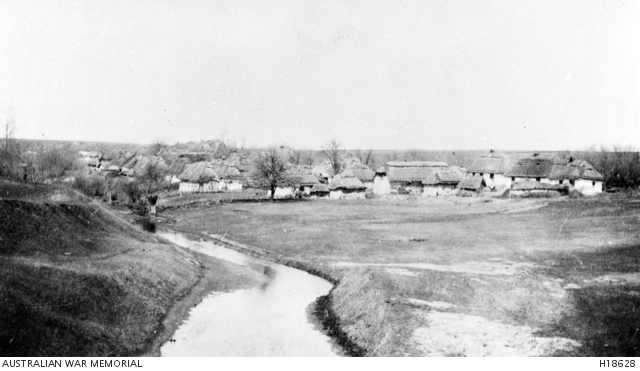The Indefatigable Florence MacDowell

Florence MacDowell in 1912 (from Private Records collection 2DRL/1138)
Florence MacDowell was born in the mid 1870s, the daughter of Swanston Hay MacDowell and Kathleen Champ. She trained as a nurse at the Alfred Hospital in Melbourne, Victoria and the Queens Hospital in Adelaide, South Australia. She opened her own hospital called ‘Windarra' at Toorak in Victoria, but later moved abroad, living mostly in Italy. She was staying on the Island of Elba in Tuscany when war broke out in 1914.
She made her way to England where she joined the British Red Cross. She worked as a Sister in their hospital at Vranatzka Banya in Serbia. In late 1915 and early 1916 the Serbian forces were overrun and retreated to Albania and Montenegro. Sister MacDowell evacuated from Serbia and eventually made her way back to England.
There she joined the Millicent Fawcett Union, under the British Red Cross. Millicent Fawcett was a suffragette and President of the National Union of Women's Suffrage Societies (NUWSS). In December 1915 the NUWSS appealed to friends and supporters for funds to help sick and homeless refugee women in Russia. The response was strong and in February 1916 a maternity hospital was opened in Petrograd.
Other hospitals followed, including an infectious hospital for civilians and soldiers in Volhynia province, almost 100 kilometres behind the Galician Front. The 80 bed hospital was established in June 1916 in a huge building in the town of Zaleschiki and was called the 52nd Epidemic Hospital. As a member of one of the Millicent Fawcett Medical Units, MacDowell became the Matron of this hospital. The beds were constantly in use with patients suffering from scarlet fever, erysipelas, dysentery and other infection diseases.
Group photograph of doctors, nursing sisters and Russian soldiers probably taken in hospital grounds.
Late in 1916 cases of smallpox were discovered in the area and a vaccination program began. They also established a smaller hospital for smallpox patients in the hope these early measures could ward off a serious outbreak.
MacDowell later became the Matron of the 92nd Surgical Hospital at Podgaetz on the Galician Front. She was in Russia during the February 1917 revolution, which resulted in the abdication of Tsar Nicolas II.
A small Galician village where smallpox raged during the autumn and winter of 1916.
In July 1917 the Germans broke through the front line and the Russians began a disorganised retreat from Galicia. Many towns were evacuated as they retreated. The Medical Unit staff at Podgaetz in Galicia were evacuated by Commander Locker Sampson of the British Armoured Car Division.
Wounded soldiers arriving at a British hospital with an English nursing sister waiting at the door. The stretchers were carried between two horses.
After leaving Russia, Matron MacDowell returned to London. along with two Army nurses she made ready to go with the British Armoured Car Division to Persia and Afghanistan, but War Office regulations forbade their going. She remained in London and worked for the Canadian Government as Investigator for the British Branch of the Board of Pensions Commissions, travelling up and down the west coast of England and to the Midlands. After the branch closed she was employed by Australia House doing the same work.
Handmade souvenir ring owned by Matron Florence MacDowell, possibly made in Russia.
She decided to live in Canada and worked for a time in migration in the east coast of Canada. She was making arrangements to work in the Artic Circle, when she fell ill and was unable to go. She returned to Australia for a period, before travelling to England where she joined the staff of Barnados as an investigator for several years. This charity for children was established in the 19th century by Doctor Thomas Barnado and ran a number of children's homes and fostering schemes. Barnados encouraged child immigration as an appropriate response to the social problems in Britain. After the First World War this policy was expanded to include Australia as a destination.
Later, Miss MacDowell returned to Australia for family reasons and spent time at Liverpool NSW. Here she interviewed the first boys to immigrate to Sydney under the Barnados scheme. She returned home to Melbourne where she took up social work with the Charity Organisation Society for a few years. She then worked for the Women's Employment Committee as Secretary and as Government Registrar under the Sustenance Department.
Wounded Russian soldiers awaiting evacuation from a British hospital. Podgaetz, Galicia. 1917.
In 1929 she acted as Organising Secretary for the Australian Women's National League in Melbourne for six months. In addition she was a member of the Returned Sailors' and Soldiers' Imperial League of Australia; Council of Health Bureau at Anzac House for returned soldier's children; the Mental Auxiliary; Women's Citizen League and the British Legion, British Serbian Units Branch. She was also an associate of the National Council of Women and Honorary Organiser of the Girl's Movement, an organisation to help guide girls into appropriate work and training them. Miss MacDowell died in Melbourne on 25 April 1939 after a long illness.




